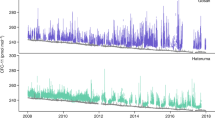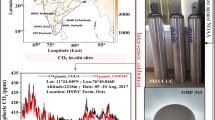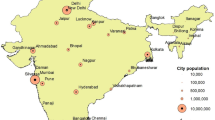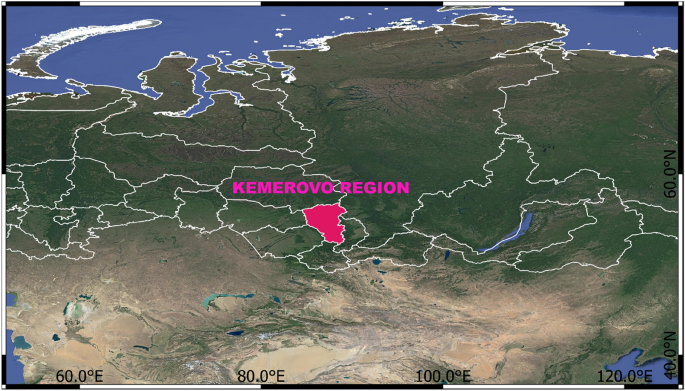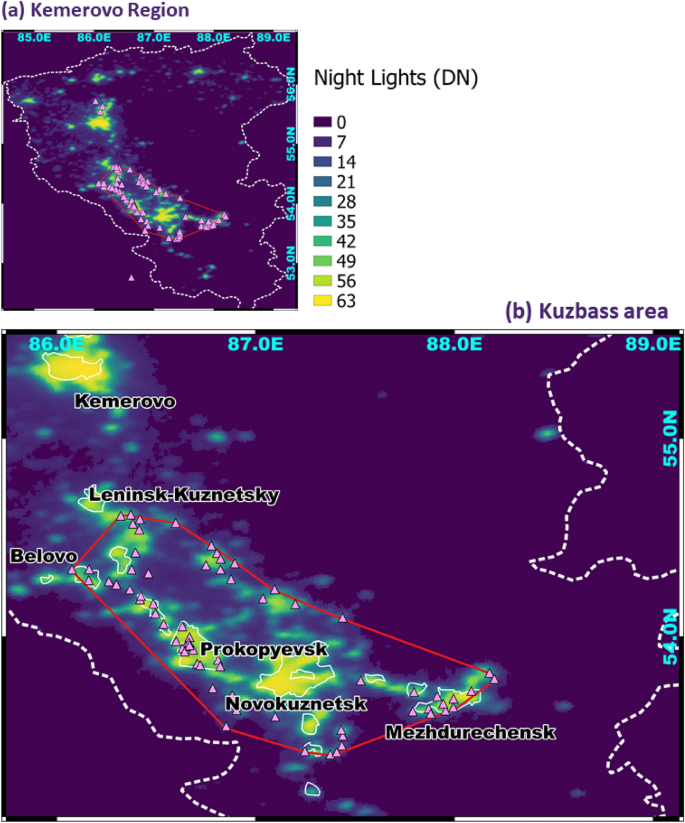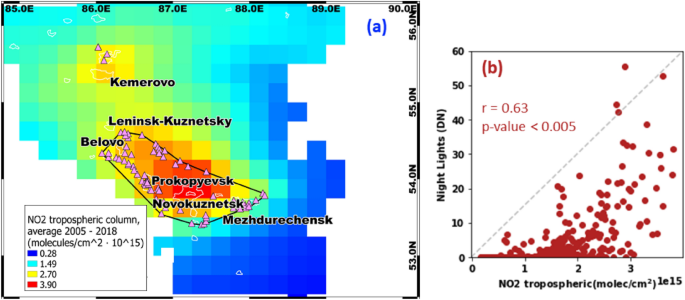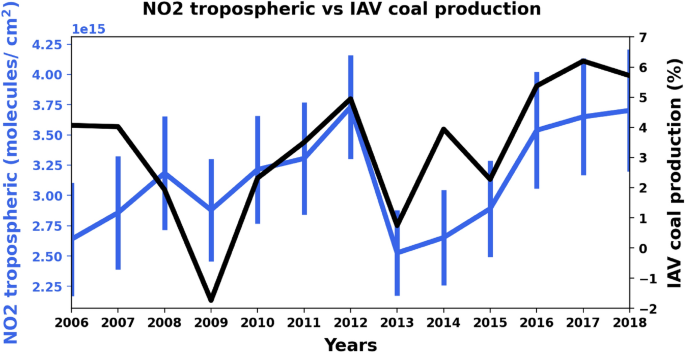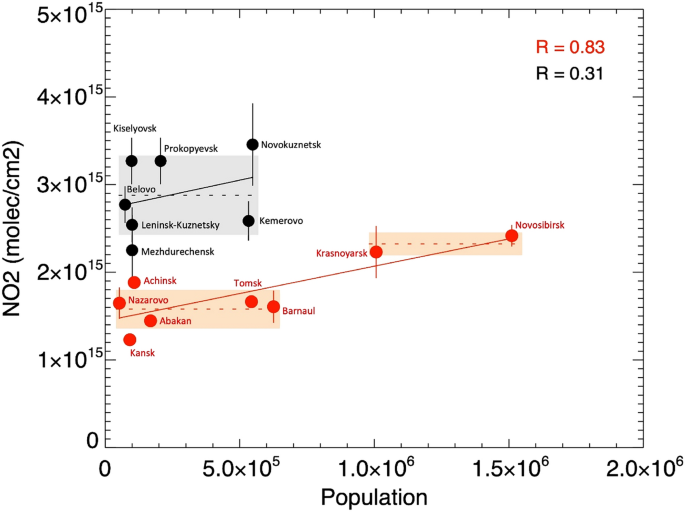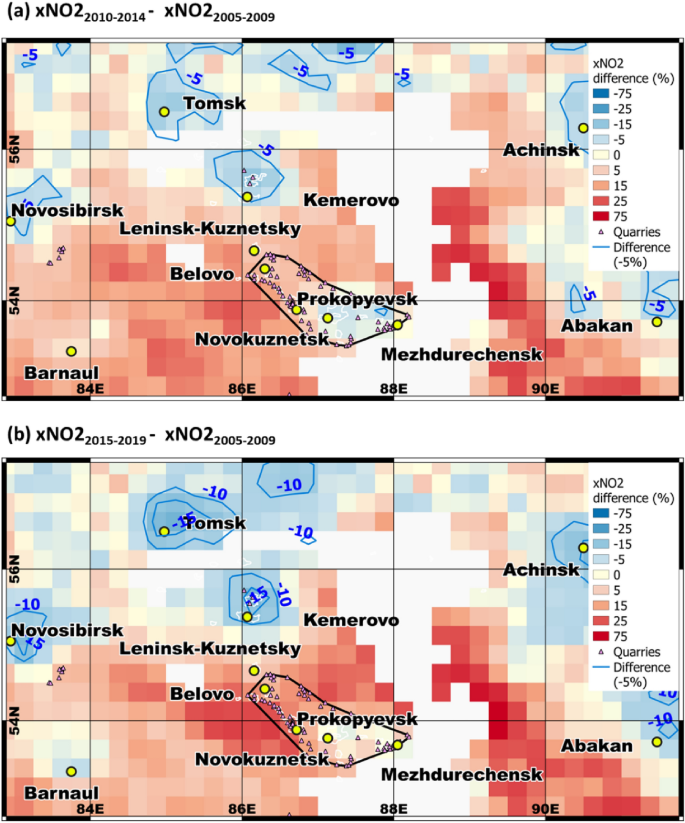Abstract
Coal use exacerbates several major environmental problems including build-up of greenhouse gases and air quality deterioration. Although Kuzbass (Siberia) is one of the largest exploited coal basins worldwide, the role of regional coal mining and processing in atmospheric pollution is unknown. We outlined the Kuzbass coal basin by spaceborne night-lights and revealed a regional, long-term tropospheric NO2 anomaly (2005–2018) by spaceborne NO2 column observations (hereafter ‒ NO2). The spatial agreement between NO2 and night-lights indicates that the anomaly is attributable to an agglomeration of coal quarries and the cities in Kuzbass, that are heavily reliant on coal. A positive relationship between NO2 and interannual coal production suggested that the anomaly was related to coal in Kuzbass; ~ 1.0% of annual coal production increase induced ~ 0.5–0.6% of NO2 enhancement. As coal production accelerated since 2010, NO2 exhibited strikingly similar annual increases over Kuzbass in 2010–2014 (7%) and 2015–2019 (15%), compared to 2005–2009. Conversely, Siberian cities lacking a coal industry followed the global trend of reducing NO2 for the same periods (−5% and −14%, respectively), driven by fuel combustion improvements. Overall, we demonstrated that coal mining, processing and utilization can induce distinct tropospheric NO2 anomalies, detectable from space.
Similar content being viewed by others
Introduction
The global reliance on coal has triggered infamously adverse environmental effects as coal has become the main contributor of the atmospheric greenhouse gas accumulation and the most atmosphere-polluting source of energy as well1. These adverse effects stem from direct emissions of coal mining (scraping and fracturing of coal from ground) as well as from indirect emissions from coal mining (fuel combustion of coal mining machinery), coal processing (production, conversion to coke, use in metal production) and coal transportation (emissions from coal-carrying vehicles)2. There is a growing corpus of studies, relying on spaceborne observations to monitor and constrain atmospheric emissions, originating from coal power plants3,4,5. However, only few investigations have considered spaceborne observations of atmospheric byproducts from areas of coal mining and processing. Previous studies have focused on developed countries such as the U.S.6 and Australia7, but 84% of the world’s coal mining and processing are in emerging and developing economies8, following the development classification of the International Monetary Fund9. Knowledge of the atmospheric byproducts of coal mining and processing is incomplete for these countries in comparison with developed countries. This is peculiarly undesirable, because officially reported emissions in these countries can be strikingly inaccurate10,11,12.
A growing research interest in Chinese coal point-sources13 has provided previously unknown information about coal byproducts in the atmosphere. However, various other emerging or developing countries remain unexplored in this respect. The post-Soviet states (accounting for 7% of global coal production) are the most salient examples of such blind-spots, considering the presence of large coal-producing regions such as Donbass in Ukraine and, especially, Kuzbass in Russia. Kuzbass, located in southwest Siberia, is the largest coal basin in Russia and one of the largest in the world (~ 300 billion tons of accessible reserves), containing 33% of the world’s known coal deposits14. Despite the global importance of Kuzbass, only Oparin et al.15 have addressed the air pollution over the region by using spaceborne remote sensing of snow cover. Besides their indirect evidence of air pollution, detectable from snow cover in Kuzbass, no other empirical work has attempted to estimate the atmospheric pollution or composition over Kuzbass. The literature contains only fragmented information about the effects of coal mining on the atmosphere over this coal-rich area such as the indication about elevated tropospheric NO2 over southwestern Siberia in 2005‒2018, visible from a NO2 concentration map of Asia in Jamali et al.16 The authors have never addressed this local increase, but such hint about a potential NO2 atmospheric enhancement over a major coal basin is intriguing because NO2 is not a common indicator of a direct coal mining outgassing. Rather, it is attributed to indirect emissions of coal mining, stemming from fuel combustion, mainly by motor vehicles17 but also by the heavy machinery and transportation vehicles involved in the mining, processing, and transportation of coal18. In this context, a regional study reported that in Kuzbass, huge amounts of coal are mined (by excavators) and transported (by haul trucks) using heavy machinery that relies on the inefficient combustion of diesel fuel19. Given the scales of coal mining in Kuzbass, such machinery generates massive amounts of NOx emissions that might increase tropospheric NO2 to levels that are seemingly harmful to respiratory and cardiovascular systems20.
For this reason, our study elucidates a potential link between coal mining/processing activities, and atmospheric NO2 over Kuzbass by using a set of spaceborne remote sensing observations: NO2 tropospheric columns from the Ozone Monitoring Instrument (OMI), night lights from the Operational Line-scan System (OLS), and urban pixels from the Moderate-resolution Imaging Spectroradiometer (MODIS). To this end, we (a) investigated the statistical agreement between NO2 and the cluster of anthropogenic activities in Kuzbass (the concentrations of urban areas, industrial clusters, and opencast coal mines in the region); (b) examined the sensitivity of NO2 to coal production (from reported data) in Kuzbass; and (c) separately compared the long-term trends of NO2 for Kuzbass cities and other cities in Siberia that have no links to the coal industry.
Results
Kuzbass is located in southwestern Siberia and lies within the Kemerovo administrative region of Russia (Fig. 1), which is specialized in mining and processing industries, occupying ~ 50% of regional economy. Kuzbass covers the area of ~ 26,000 km14, contains ~ 300 billion tons of coal14, and is responsible for 58% of coal produced in Russia and 70% of exported coal21. Most of the coal (63.8%) is mined in open pits22, and there are 90 such mines23. Compared with other coal-rich regions in Russia, Kuzbass is a hotspot of coal mining, processing and utilization because of its mild climate and near-surface coal seams, which are conductive for open-pit mining and are cost-effective21. The adverse environmental impacts of coal-related industry in Kuzbass are clear, including 2.5 billion tons of waste (50% of the solid waste in Russia), with 98% of this waste originated from mining activities22.
Location of the Kemerovo region (pink area). Top-level administrative boundaries in Russia are shown in white. The satellite map provided by Google Maps is embedded using the QucikMapServices plugin of QGIS software (0.19.29 https://nextgis.com/blog/quickmapservices/).
While the boundaries of Kemerovo region are administratively defined (Fig. 1), the boundaries of the Kuzbass basin can vary depending on the application. There is no robust, validated map of Kuzbass coal quarries, compiled by established surveying techniques. Given the small size of the study area and the visual prominence of quarries against the green vegetation of the surrounding taiga ecosystem, we used Google Earth imagery and manually marked the centers of the largest mines in the region (Fig. S2, Supplementary Material). As a result, 81 open coal quarries were outlined (out of 90 reported open quarries23). These quarries were used to create a polygon by connecting all the marginal coal quarries within the geographical cluster in the center of Kemerovo region with most identified quarries (68/81) within (red line, Fig. 2). This cluster reflects the heartland of the regional coal basin and is hereafter referred to as Kuzbass.
The delineated cluster of coal quarries and large cities, representing Kuzbass, shown on (a) the Kemerovo administrative region map (dashed white line) with Kuzbass coal basin (red polygon) and on (b) the zoomed-in map of the Kuzbass coal basin (red polygon) with the detected open coal quarries (triangles), MODIS urban pixels (white solid line) and night-lights (black-yellow gradient).
As shown in Fig. 2, we validated the mapping of mines in Kuzbass by using the latest estimates of cloud-free night lights from OLS measurements, which are a proxy for human activity24. Areas with opencast mines operated during the night normally exhibit distinct local increases in the digital number (DN) of night lights25. We also used the map of urban areas from MODIS, based on the unique phenology of build-up areas26 to distinguish cases of increased night lights originating from urban areas (when the lights align with the MODIS urban map) from cases of increased night lights from a coal mine outside a built-up zone (when there is no overlap of lights with the MODIS urban map). A lack of overlap of night-lights with the urban population data has been previously used to identify night light signals that are unrelated to cities27. Figure 2 demonstrates that the mapping of the Kuzbass quarries realistically reflected the regional patterns of urbanization and the coal quarry allocation. The combination of coal mine mapping with night lights and the MODIS urban map (Fig. 2) hints at three broad types of area modified by human activity in Kuzbass: (1) urban areas without mines, identified by strong night lights overlapping with the MODIS urban map. An example is Novokuznetsk, a major regional conurbation with an industrial economy, specializing in metal production28, but relatively weak underground coal mining. The second (2) is urban areas that include coal mines. The urban areas are identified as above, but there are also coal mines, identified within the outlined areas. Examples are Mezhdurechensk and Prokopyevsk, cities planned and evolved exclusively as coal mining centers. The third area type is (3) coal mining zones, characterized by moderate night light intensity and the presence of mines but with no overlap with MODIS urban pixels. Note the difference between Kemerovo region (one of Russia’s top-level political divisions, shown in Figs. 1 and 2a) and Kemerovo City, the region’s capital city (an urban area; uppermost city in Fig. 2b).
As mentioned, a distinct increase of tropospheric NO2 over southwestern Siberia had been evidenced in a previous study16, but remained uncommented by its authors. We calculated the average NO2 for 2005–2018 and revealed two distinct NO2 spatial enhancements (e.g., positive anomalies) over southwestern Siberia as well, namely, over Kemerovo region (Fig. 3a). These two major long-term NO2 anomalies were centered approximately over the regional industrial centers of Novokuznetsk (the major southern anomaly; peak NO2 ~ 4.25 × 1015 molecule/cm2) and Kemerovo City (the minor northern anomaly; peak NO2 ~ 2.90 × 1015 molecule/cm2). The maximum values of both anomalies corresponded to large urban areas with a population of ~ 0.5 million people. Moreover, the spatial gradient of NO2 anomaly, we identified (Fig. 3a) is consistent with that reported by Jamali et al.16 over this area. Specifically, the major southern NO2 anomaly showed the greatest NO2 concentration in the center, which gradually weakened toward the borders of the identified cluster of coal mines in Kuzbass (black outline in Fig. 3a). Tropospheric NO2 over Kuzbass was somewhat high, with an average of 3.22 ± 0.52 × 1015 molecule/cm2 within the outlined cluster of coal mines.
(a) Spatial distribution of average NO2 tropospheric column (2005–2018) over Kemerovo region and Kuzbass (constrained by black outline), illustrated by the blue-red gradient, coal quarries in the region (triangles) and MODIS urban pixels (white lines); (b) Scatter plot of night light (DN) and the corresponding NO2 average over Kuzbass (within the polygon, outlined by black in a) for each 0.25° × 0.25° pixel. A note: the abrupt change in NO2 concentration at the eastern margin of the Kuzbass region (blue color in a) is not related to night lights (i.e., anthropogenic activity), but to the local topography. In fact, the eastern margin of the region has the highest elevation in the study area (600‒1050 m above sea level, asl; Fig. S3 in the Supplementary Material). NO2 generally accumulates under two topographic conditions: the hindered dispersion of pollutants due to low penetration of winds in a trough, and pollution being trapped near the ground surface by temperature inversions formed by surrounding mountains44. The center of Kuzbass (the strongest NO2 anomaly, red in a) is subjected to these topographic conditions, as it is located in a trough (~ 250 m asl) surrounded by hills (Fig. S3). It is therefore likely susceptible to temperature inversions, but there were no regional meteorological studies to evaluate this hypothesis in detail.
Most interestingly, the surge in night lights (Fig. 2) looks strikingly similar to the elevated NO2 over the coal basin in Kuzbass (Fig. 3a). The borders of the elevated NO2 did not align with the Novokuznetsk metropolitan area (white outline labeled Novokuznetsk in Fig. 3), but spatially coincided with the large cluster of coal mines. As the NO2 southern anomaly was unevenly distributed over the cluster of coal mines, we estimated the quantitative agreement between this anomaly and the night-light intensity, which reflects local human activity. Figure 3b reveals a moderate agreement between night lights and NO2 within Kuzbass coal basin (Pearson correlation coefficient, r = 0.63 at p-value < 0.005), thereby corroborating the association between human activity and the NO2 anomaly in the region. Although the correlation between the intensity of night lights over Kuzbass and the NO2 anomaly is imperfect (r = 0.63; Fig. 3b), this finding demonstrates that this cluster of mines is likely the main anthropogenic driver of NO2 emissions in the region. Notably, previous studies that considered NO2 from OMI and night lights25,29, did not find such a strong correlation.
To assess the spatial association between coal mining/processing, and the NO2 anomaly over Kuzbass, we estimated the statistical agreement between them for 2006–2018. This period differs from that in the previous section due to the availability of coal production data. At first glance, there was no strong correlation between the annual coal production rates and annual averages of NO2 over Kuzbass (r < 0.50). Although NO2 did not exhibit any significant temporal trend in Kuzbass in 2006–2018 (p-value > 0.05 based on a Mann-Kendal trend test), coal production exhibited clear increasing trend in the same period (p-value < 0.05, slope = 5.99). As coal production is often a monotonically increasing quantity and it exhibited clear increasing trend in Kuzbass, the actual variability in production can be hidden in an inter-annual signal. Hence, we tested the inter-annual variability (IAV) of coal production, a method previously applied to similar monotonically increasing quantities such as fossil fuel emissions30. Fundamentally, IAVcoal reflects the difference (%) between an annual estimate of coal production during year n minus the coal production of year n- 1. We identified reasonable agreement (r = 0.60) between IAVcoal and the annual average estimates of NO2 over Kuzbass (Fig. 4) despite seemingly incomplete regional coverage by OMI observations during these years.
Annual average tropospheric NO2 (blue line with error bars representing one standard deviation) and coal production IAV (black line) in Kuzbass for the years 2006–2018 (see Table S5 in supplementary material for numerical estimates) of NO2 tropospheric column.
Although the statistical correlation is apparent, it was weakened by a few prominent differences in trend between NO2 and IAVcoal, such as in 2007‒2008 (Fig. 4), when the world economic crisis struck most countries including Russia. IAVcoal fell below 0%, which is the sole decrease in coal production in Kuzbass over the 11 year study period. The decline in coal production was more rapid than the general weakening of socio-economic activity within urban areas. This phase difference was driven by the dramatic increase in the cost of transporting coal. In particular, railway transportation (99% of coal is transported from Kuzbass to other regions by train) reached 40% of the Russian coal price in 200831. Moreover, declines in related industries (iron, steel, chemical, and power) abruptly constrained the supply of resources required for coal mining31. In contrast, activities in urban areas were not so immediately affected by these factors.
The importance of coal production as one of the major drivers of NO2 anomaly over Kuzbass was further evaluated by analyzing statistical agreement between city-scale estimates of NO2 and population count from the national inventories32. This evaluation was based on the knowledge that in most cities, population, not coal is the main driver of NO233. To this end, two types of cities were used in the analysis: the major cities of Kuzbass (black circles) and the neighboring major cities in Siberia (red circles) in Fig. 5. This analysis revealed two distinct patterns. First, NO2 over most Kuzbass cities (> 2.5 × 1015 molecule/cm2 except Mezhdurechensk) was distinctly higher, compared with other Siberian cities (< 2.5 × 1015 molecule/cm2 except Novosibirsk; the largest city of Siberia). Second, the strong linear association between NO2 and population was discerned for other Siberian cities (r = 0.83), thereby, confirming the common, population-related driver of NO2 in these cities. Notably, the correlation between OMI-based NO2 and population in these Siberian cities is higher than for cities in the U.S., Europe, China, and India34. However, despite the similar number of compared points, there was no such agreement for the Kuzbass cities (r = 0.31), indicating that population size was not the main driver of NO2 in Kuzbass. Figure 5, illustrating the relationship between NO2 and population in Siberia, indirectly suggests that the recorded NO2 levels in Kuzbass would correspond to a city with a population of > 2.5 million inhabitants. Overall, the combination of such high NO2 tropospheric concentration and the lack of relationship with population points to the existence of another driver of the NO2 increase in Kuzbass, unrelated to population, which might be coal-associated activities including mining, processing, transportation, and utilization of coal.
Scatter plot of mean OMI NO2 and population for the main cities in the Kuzbass basin (black circles) and surrounding Siberian cities (red circles) for the same time period as Fig. 4. The dot labeled ‘Kemerovo’ indicates Kemerovo city. Shaded regions highlight the standard deviation and the mean (horizontal dashed lines) of the population of the cities larger than about 1,000,000 inhabitants and lower than about 500,000 inhabitants.
Coal mining and processing activities were likely among the main drivers of the NO2 anomaly over Kuzbass, given the direct evidence (the overlap between the NO2 anomaly and the cluster of coal mines, and the correlation between coal production and tropospheric NO2 over Kuzbass) and indirect evidence (tropospheric NO2 over Kuzbass not being related to population). This is intriguing and raises the question of whether monotonically increasing coal production affected the strength of the NO2 anomaly over Kuzbass. To answer this question, we relied on previous findings, which reported dramatic decreases of spaceborne-based NO2 (40% for some cities in the U.S.) over urban areas worldwide in 2015, compared with 2005 due to technological improvements and stricter regulations of emissions34. As these regulations were mostly underpinned to vehicular and stationary emissions, we tested whether the Russian NO2 hotspots were within this decreasing global trend of the NO2, by assuming that the coal mining/processing activities were not affected by these measures. If this hypothesis is correct, the NO2 change over Kuzbass would differ from that over the Siberian urban areas outside Kuzbass (red circles in Fig. 5). Therefore, we retrieved average NO2 over a broad geographic area around Kuzbass for the baseline period (2005–2009) when these regulations had not yet been enacted. We repeated this for two subsequent periods (2010–2014 and 2015‒2019) when the regulations were assumed to have affected the related emissions. Figure 6 shows the differences between each of the latter periods and the baseline period.
Change in average NO2 from 2005–2009 to (a) 2010–2014 and (b) 2015–2019. Blue shading represents a decrease in NO2 and red indicates an increase. Yellow circles mark the largest cities in the region, and small pink triangles indicate coal mines. The pixel size is 0.25° × 0.25°. This analysis was conducted for retrieving NO2 over areas with elevated NO2 concentrations, including cities and the cluster of coal mines in Kuzbass, whereas the hinterlands were less important for this analysis given the lower tropospheric NO2 over these areas (Fig. 3). To this end, the NO2 data from areas with relatively low NO2 were masked out (white areas). Areas with low NO2 were defined as follows: the NO2 concentration for a 0.25 × 0.25 grid cell is less than the mean NO2 concentration over Kuzbass for the period 2005–2019.
Interestingly, two distinctly different patterns were identified. First, the Siberian urban NO2 hotspots outside Kuzbass did follow the decreasing global trend as NO2 in 2010‒2014 has been reduced on -5% over such cities as Achinsk, Novosibirsk, Abakan, Kemerovo (are shown in Fig. 6a) and Krasnoyarsk (outside the map of Fig. 6a), compared to the baseline period. Moreover, the NO2 reductions have continued over these Siberian cities (reaching − 14%) in 2015‒2019, compared to the baseline period, whereas the more recent reduction of NO2 (− 4%) was registered over Barnaul (Fig. 6b). At the same time, the dynamics over the Kuzbass basin (and related coal quarries), except a minor regional cluster, were strikingly opposite. There was a prominent increase of NO2 over Kuzbass, whereas the average NO2 over coal quarries within Kuzbass increased on ~ 7 ± 5% and ~ 15 ± 8% in 2010–2014 and 2015–2019, respectively, compared to the baseline period. The only exception was a minor regional cluster in Kuzbass near Mezhdurechensk, where NO2 remained nearly unchanged in 2009–2019, compared with the baseline period (0–1% change). We suggest this was due to its topography, as the city is at the highest point in Kuzbass (532 m asl; Fig. S1), which is otherwise mostly flat (< 400 m asl). Another factor might be the lack of coal production plants within Mezhdurechensk, whereas Belovo and Kiselevsk each have two, and Prokopyevsk has one (Table S4 in the Supplementary Material). The latter factor potentially indicates that the combination of coal mining activities (i.e., mines) and coal production facilities (i.e., coal preparation plants) exacerbates the atmospheric NO2 anomaly in the Kuzbass cities with both coal mining and processing activities.
Novokuznetsk, which is also within Kuzbass, exhibited a slightly different pattern from the increasing NO2 seen over Kuzbass (Fig. 6). In particular, NO2 levels fell in 2010–2014 (by 4% relative to 2005–2009), and subsequently returned to the baseline level in 2015–2019. The different pattern for Novokuznetsk is reasonable, as the city is located within Kuzbass but has no coal mines (see Fig. 2) because it specializes in industrial production28, where ~ 62% of city enterprises produce, supply or support the production of metal35. Interestingly, although Novokuznetsk is not a city with coal-oriented economy, coal is actively used as input in its production of metal as conversion of most or all metal ores to usable metal is highly energy intensive. Metal production facilities use coal to provide energy and the metals are being produced by conversion of coal to coke, where both processes emit substantial NO2 emissions in the atmosphere. Although the data on metal production of Novokuznetsk is scanty, we analyzed Novokuznetsk inventory-based NO2 emissions from a previous study36. Notably, NO2 emissions from metal production of West-Siberian Metal Plant (WSMP) account for 84.2% of all the gaseous pollutants of Novokuznetsk36 in 2014–2018. Most importantly, we found high correlation (r = 0.76) between inventory-based NO2 emissions from WSMP36 and our annual NO2 tropospheric estimates from OMI and, where even higher correlation (r = 0.84) was discerned between WSMP NO2 emissions and coal production from Fig. 4. These findings clearly indicate that metal manufacturing of Novokuznetsk is based on coke-intensive input, thereby pointing on a key role of coal in these emissions.
Discussion
The sensitivity of tropospheric NO2 (measured by OMI) to the mining, production, and transportation of coal in Russia’s largest coal basin (Kuzbass) was demonstrated for the first time. A major long-term tropospheric NO2 anomaly was revealed over Kuzbass (3.22 ± 0.52 × 1015 molecule/cm2) in the period 2005–2018, indicating substantial gaseous pollution over the region. The anomaly was attributed to the Kuzbass coal basin, based on moderate agreement identified between (1) the spatial distributions of NO2 and night lights originating from the cluster of coal mines and cites, as well as by (2) the correlation between inter-annual coal production and annual NO2 levels in Kuzbass (r ≥ 0.60). Unlike the global trend of NO2 reduction over urban areas (including Siberian cities), NO2 substantially increased over Kuzbass in the 2010–2014 and 2015–2019 periods (7% ± 5% and 15% ± 8%, respectively, relative to a baseline period of 2005–2009). The total coal production in Kuzbass was 888, 993, and 1,151 million tons in the periods 2005–2009, 2010–2014, and 2015–2019, respectively. Production in the two latter periods increased by 11% and 30%, respectively, compared with the baseline period. Remarkably, such increases seem to be strikingly proportional to our reported NO2 increments over the Kuzbass basin during the same period. Assuming a proportional relationship between NO2 and coal production, a ~ 1.0% increase in coal production is likely to cause a ~ 0.5%–0.6% increase in the NO2 concentration in the region, where some portion of this increase may have been offset by regulations limiting emissions.
From regional perspective, the demonstrated association between tropospheric NO2 with coal mining and processing activities over the largest coal basin in Russia is valuable, given the limited opportunity to otherwise assess the environmental impacts of coal-related activities in developing/emerging economies such as Russia, where official information is often inaccurate and atmospheric observations are scarce. These first estimates of substantial tropospheric NO2 increases over Kuzbass can encourage national and regional policy makers to formulate new pollution mitigation strategies to assess and to minimize the local population’s exposure to the adverse cardiovascular and respiratory effects of tropospheric NO2 and also O3, as NO2 is a precursor of O3. Moreover, elevated atmospheric NO2 may cause indirect adverse environmental effects such as nitrogen enrichment of water bodies via deposition, which compromises the safety of drinking water as well37.
Our findings are novel at a global level, as most existing spaceborne studies focusing on coal mining have reported increases in atmospheric CH46,7,38,39. Although we demonstrated that spaceborne observations of NO2 can be utilized to attribute NO2 pollution to previously unreported coal mining and processing over large exploited coal basins, the hypothesis that coal mining itself can be a major source of NO2 emissions should be evaluated. The tropospheric NO2 anomaly over Kuzbass could be driven both by direct nitrogenous outgassing from coal mining (e.g., scraping and fracturing) and indirect nitrogenous emissions from coal mining and processing. Such indirect nitrogenous emissions originate from the inefficient compression-ignition diesel engines of coal mining equipment (excavators), coal transportation vehicles (haul trucks) and from nearby facilities for processing coal. Notably, the combustion of heavy fuel by the haul trucks deployed in Kuzbass has already been questioned from an ecological viewpoint19. Although new heavy machinery meeting Euro-3 and Euro-4 standards is being delivered to Kuzbass, there remains an abundance of inefficient diesel-fueled equipment prone to emitting NOx19. Moreover, as preliminarily indicated, such indirect coal emissions can stem from manufacturing of steel, which uses coke in the production, thereby generating various indirect air pollutants including NO2.
We encourage future studies to use Tropospheric Monitoring Instrument (TROPOMI) observations for the high-resolution analysis of NO2 over Kuzbass as the region is virtually unknown by the TROPOMI research community. Such studies could accurately estimate emissions from coal-related sources in Kuzbass by implementing inversions into atmospheric transport models with high-resolution spaceborne NO2 observations as the input. In this context, the combination of TROPOMI observations with the emission estimates from inventories can (a) disentangle direct emissions from coal mining and processing from indirect emissions originating from the inefficient fuel combustion of coal mining machinery and coke production of steel industry. Moreover, in this way, one can (b) elucidate the contributions of other human activities unrelated to coal mining to the identified NO2 anomaly over Kuzbass. Once these aspects are clarified, further research can estimate the coal mining-induced direct nitrogenous outgassing from Kuzbass.
Methods
Proxy data: anthropogenic activities and coal production in Kuzbass
As no institution has consistently reported statistics on coal production in Kuzbass, we collected fragmented data in coal production from various sources including the Administration of Kemerovo Region, the Department of Coal Mining/Production of Kemerovo Region, and the journal Coal of Kuzbass. We compiled coal production statistics for the available years (2006‒2018) in Table 1. For further information, see the Supplementary Information and the online compilation of references (https://gitlab.com/labzovskii/kuzbcoal/).
OMI NO2
OMI is a spectrometer onboard the NASA’s EOS-Aura satellite, which is operated in the ultraviolet–visible range (visible channel is used for NO2 retrieval) since 15 July 2004 at sun-synchronous orbit40. We used the retrievals of NO2 tropospheric column, shortly referred as NO2 (Level 3 data, 30% cloud screened product called ‘OMNO2dv003’) in 2005–2018 period. The number of molecules of NO2 in atmospheric column were applied with only near-clear sky conditions (cloud radiance fraction < 30%). The spatial resolution of NO2 estimates is 0.25° × 0.25°, produced by the averaged observations (originally ranging from ~ 13 km × 24 km in near nadir to ~ 24 km × 160 km for the observations at the edge of a swath) over a grid cell of interest41. The version 3 retrieval stands out with high accuracy of retrievals of NO2 slant column density42. This study used the long-term averages (2005–2018) of NO2 as representative long-term estimates over a broad region, following previous studies16 and prior indications about the link between coal mining and processing activities and NO2 emissions43. The period of 2005–2018 was selected for OMI based on the availability of coal production data, namely, from the first year with full year OMI NO2 coverage until 2018, the last year for which the coal production in Kuzbass was available. The analysis was extended on one year (2005–2019) for Fig. 6 as we did not need to use coal production as a reference the analysis, shown on this figure. We also calculated annual averages of NO2 over the region of interest (Kemerovo Region and Kuzbass), and provided the corresponding standard deviations. The data were accessed (on 07.12.2021) using the Giovanni tool of the NASA EarthData service (https://disc.gsfc.nasa.gov/information/tools?title=Giovanni).
Data availability
The sources of the used data are mentioned in the “Methods”. Other generated data and tools are available upon request by any user; they are both freely available to any researcher wishing to utilize them for non-commercial purposes, without breaching participant confidentiality. To request the data from this study, please contact LL (labzowsky@gmail.com).
References
Pandey, B., Gautam, M. & Agrawal, M. Greenhouse gas emissions from coal mining activities and their possible mitigation strategies. In Environmental Carbon Footprints (ed. Muthe, S. S.) 259–294 (Elsevier, Amsterdam, 2018).
Pandey, B., Agrawal, M. & Singh, S. Assessment of air pollution around coal mining area: Emphasizing on spatial distributions, seasonal variations and heavy metals, using cluster and principal component analysis. Atmos. Pollut. Res. 5–1, 79–86 (2014).
Wang, S. et al. Satellite measurements oversee China’s sulfur dioxide emission reductions from coal-fired power plants. Environ. Res. Lett. 10, 114015 (2015).
Shikwambana, L., Mhangara, P. & Mbatha, N. Trend analysis and first time observations of sulphur dioxide and nitrogen dioxide in South Africa using TROPOMI/Sentinel-5 P data. Int. J. Appl. Earth Obs. Geoinformation 91, 102130 (2020).
Hakkarainen, J. et al. Analyzing nitrogen oxides to carbon dioxide emission ratios from space: A case study of Matimba Power Station in South Africa. Atmos. Environ. X 10, 100110 (2021).
de Gouw, J. A. et al. Daily satellite observations of methane from oil and gas production regions in the United States. Sci. Rep. 10, 1379 (2020).
Sadavarte, P. et al. Methane emissions from super-emitting coal mines in Australia quantified using TROPOMI satellite observations. Environ. Sci. Technol. 55(24), 16573–16580 (2021).
BP 2021 British Petroleum Statistical Review of World Energy July 2021 (coal production). Accessed from https://www.bp.com/content/dam/bp/business-sites/en/global/corporate/xlsx/energy-economics/statistical-review/bp-stats-review-2021-all-data.xlsx (2021).
IMF (International Monetary Fund) 2015 World Economic Outlook: Adjusting to Lower Commodity Prices. http://www.imf.org/external/pubs/ft/weo/2015/02/pdf/text.pdf (2015).
Guan, D., Liu, Z., Geng, Y., Lindner, S. & Hubacek, K. The gigatonne gap in China’s carbon dioxide inventories. Nat. Clim. Change 2, 672–675 (2012).
Li, M. et al. MIX: A mosaic Asian anthropogenic emission inventory under the international collaboration framework of the MICS-Asia and HTAP. Atmos. Chem. Phys. 17, 935–963 (2017).
Oda, T. et al. Errors and uncertainties in a gridded carbon dioxide emissions inventory. Mitig. Adapt. Strateg. Glob. Change 24, 1007–1050 (2019).
Guanter, L. et al. Mapping methane point emissions with the PRISMA spaceborne imaging spectrometer. Remote Sens. Environ. 265, 112671 (2021).
Britannica 2021 Kuznetsk coal basin. https://www.britannica.com/place/Kuznetsk-Coal-Basin (2021).
Oparin, V. N. et al. Evaluation of dust pollution of air in Kuzbass coal-mining areas in winter by data of remote earth sensing. J. Min. Sci. 50, 549–558 (2014).
Jamali, S., Klingmyr, D. & Tagesson, T. Global-scale patterns and trends in tropospheric NO2 concentrations, 2005–2018. Remote Sens. 12, 3526 (2020).
Han, X. & Naeher, L. P. A review of traffic-related air pollution exposure assessment studies in the developing world. Environ. Int. 32, 106–120 (2006).
Seol, E. et al. Well-to-wheel nitrogen oxide emissions from internal combustion engine vehicles and alternative fuel vehicles reflect real driving emissions and various fuel production pathways in South Korea. J. Clean. Prod. 342, 130983 (2022).
Protasov, S. I. et al. Experience in ensuring ecological safety of operation of the open-cut equipment with internal combustion engines. Occup. Saf. Ind. 9, 66–70. https://doi.org/10.24000/0409-2961-2017-9-66-70 (2017).
Zhao, S., Liu, S., Sun, Y., Beazley, R. & Hou, X. Assessing NO2-related health effects by non-linear and linear methods on a national level. Sci. Total Environ. 744, 140909 (2020).
Cherdantsev, G. & Thurner, T. The economic future for Russia’s Kuzbass coal mining region. Int. J. Oil Gas Coal Technol. 16(4), 390–401 (2017).
Kopytov, A. I., Manakov, Y. A. & Kupriyanov, A. N. Development of coal production and the challenges of ecosystem conservation in Kuzbass. J. Ugol. 3, 72–77 (2020) ((in Russian)).
Rumyantseva, L. L. & Karlovich, I. A. Geography and ecology of the coal basins of Russia (by the example of Kuzbass). The proceedings of the conference of days of the science of students of Vladimir State University, 12 March–06 April 2018, 2193–2325 (2018). elibrary.ru https://elibrary.ru/item.asp?id=37231798
Elvidge, C. D. et al. Overview of DMSP nightime lights and future possibilities. Joint Urban Remote Sensing Event 2009 Joint Urban Remote Sensing Event (Shanghai, China: IEEE) pp 1–5 http://ieeexplore.ieee.org/document/5137749/ (2009).
Jiang, W. et al. Assessing light pollution in China based on nighttime light imagery. Remote Sens. 9(2), 135 (2017).
Schneider, A., Friedl, M. A. & Potere, D. A. New map of global urban extent from MODIS satellite data. Environ. Res. Lett. 4, 044003 (2009).
Li, C. et al. Satellite observation of pollutant emissions from gas flaring activities near the Arctic. Atmos. Environ. 133, 1–11 (2016).
Chechenin, G. I., Day, R., Gregoriev, Y., Rusaev, Y. & Surzhikov, V. D. Public health trends in a transitional Russian city (1959–1994). In Air Pollution in the Ural Mountains (eds Linkov, I. & Wilson, R.) 239–240 (Springer, Berlin, 1998). https://doi.org/10.1007/978-94-011-5208-2_19.
Fan, J. et al. Spatiotemporal variations and potential sources of tropospheric formaldehyde over eastern China based on OMI satellite data. Atmos. Pollut. Res. 12, 272–285 (2021).
Labzovskii, L. D. et al. What can we learn about effectiveness of carbon reduction policies from interannual variability of fossil fuel CO2 emissions in East Asia?. Environ. Sci. Policy 96, 132–140 (2019).
Solovenko, I. S., Trifonov, V. A. & Nagornov, V. I. Russian coal industry amid global financial crisis in 1998 and 2008. Appl. Mech. Mater. 682, 586–590 (2014).
GKS 2010 National Russian Survey. http://www.gks.ru/free_doc/new_site/perepis2010/croc/perepis_itogi1612.htm (2010).
Lamsal, L. N., Martin, R. V., Parrish, D. D. & Krotkov, N. A. Scaling relationship for NO2 pollution and urban population size: A satellite perspective. Environ. Sci. Technol. 47, 7855–7861 (2013).
Krotkov, N. A. et al. Aura OMI observations of regional SO2 and NO2 pollution changes from 2005 to 2015. Atmos. Chem. Phys. 16, 4605–4629 (2016).
Official website of the Novokuznetsk city (archived weblink) https://web.archive.org/web/20170127002333/http://portal.admnkz.info/city/passport; the latest date of the access: 05.07.2022
Savina, I. N. et al. Environmental policy of the Novokuznetsk city under conditions of modern requirements of metal production industry. Ecol. Ration. Environ. Manag. 7, 512–520 (2020).
Melillo, J. M. Disruption of the global nitrogen cycle: A grand challenge for the twenty-first century. Ambio 50(4), 759–763. https://doi.org/10.1007/s13280-020-01429-2 (2021).
Krings, T. et al. Quantification of methane emission rates from coal mine ventilation shafts using airborne remote sensing data. Atmos. Meas. Tech. 6, 151–166 (2013).
Weaver, C. et al. Retrieval of methane source strengths in Europe using a simple modeling approach to assess the potential of spaceborne lidar observations. Atmos. Chem. Phys. 14, 2625–2637 (2014).
Levelt, P. F. et al. Science objectives of the Ozone Monitoring Instrument. IEEE Trans. Geosci. Remote Sens. 44, 1199–1208 (2006).
Krotkov, N. A. et al. OMI/Aura NO2 cloud-screened total and tropospheric column L3 global gridded 0.25 degree x 0.25 degree V3, NASA Goddard space flight center, Goddard Earth Sciences Data and Information Services Center (GES DISC), 10.5067/Aura/OMI/DATA3007
Krotkov, N. A. et al. The version 3 OMI NO2 standard product. Atmos. Meas. Tech. 10, 3133–3149 (2017).
Kozak, Z., Figurski, A., Niecko, J. & Kozak, D. Concentrations of atmospheric SO2, NO2 and dust in the Lublin coal basin area. Sci. Total Environ. 96, 67–85 (1990).
Wallace, J., Corr, D. & Kanaroglou, P. Topographic and spatial impacts of temperature inversions on air quality using mobile air pollution surveys. Sci. Total Environ. 408, 5086–5096 (2010).
Acknowledgements
This research was supported by the Environment Research and Technology Development Fund (JPMEERF21S20807) of the Environmental Restoration and Conservation Agency of Japan. The part of this research has been conducted in KNMI (The Royal Netherlands Meteorological Institute). The authors acknowledge all the researchers who provided their minor, but valuable advice during the preparation of the manuscript. The acknowledgments for the producers of the data are provided below. We thank the producers of the OMI (NO2), MODIS (urban pixels), DMSP-OLS (night lights) data and those involved in the collection of the Russian survey statistics including the coal production and the population count. We thank the proof-reading company Stallard Scientific Editing for providing English language editing service. We acknowledge the Google Maps Services which was used to outline the coal quarries in this study. The first author acknowledges L. N. Labzovskii and E. N. Bezrukova for the long-term support of his scientific activities. Importantly, the authors dedicate their efforts in this work to all the people, who lived or worked in the challenging conditions of the Kuzbass region, hoping that the current study will attract the attention of scientists and international community to its socio-economic challenges and environmental problems, that are nearly unknown worldwide.
Author information
Authors and Affiliations
Contributions
The original idea of this study belongs to both L.L. and D.B. Manuscript writing and preparation, data preparation + data analysis, conceptual framework—L.L.; data analysis, manuscript editing and preparation—D.B.; manuscript editing and preparation, data analysis—A.D. All authors have reviewed the manuscript.
Corresponding author
Ethics declarations
Competing interests
The authors declare no competing interests.
Additional information
Publisher's note
Springer Nature remains neutral with regard to jurisdictional claims in published maps and institutional affiliations.
Supplementary Information
Rights and permissions
Open Access This article is licensed under a Creative Commons Attribution 4.0 International License, which permits use, sharing, adaptation, distribution and reproduction in any medium or format, as long as you give appropriate credit to the original author(s) and the source, provide a link to the Creative Commons licence, and indicate if changes were made. The images or other third party material in this article are included in the article's Creative Commons licence, unless indicated otherwise in a credit line to the material. If material is not included in the article's Creative Commons licence and your intended use is not permitted by statutory regulation or exceeds the permitted use, you will need to obtain permission directly from the copyright holder. To view a copy of this licence, visit http://creativecommons.org/licenses/by/4.0/.
About this article
Cite this article
Labzovskii, L.D., Belikov, D.A. & Damiani, A. Spaceborne NO2 observations are sensitive to coal mining and processing in the largest coal basin of Russia. Sci Rep 12, 12597 (2022). https://doi.org/10.1038/s41598-022-16850-8
Received:
Accepted:
Published:
DOI: https://doi.org/10.1038/s41598-022-16850-8
Comments
By submitting a comment you agree to abide by our Terms and Community Guidelines. If you find something abusive or that does not comply with our terms or guidelines please flag it as inappropriate.

